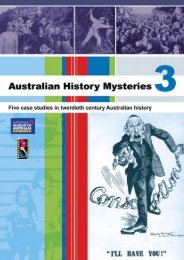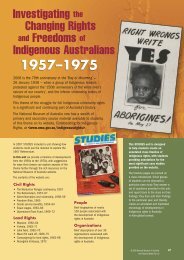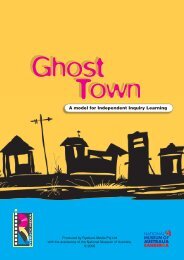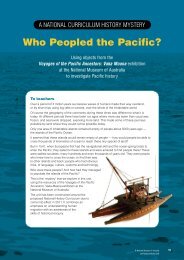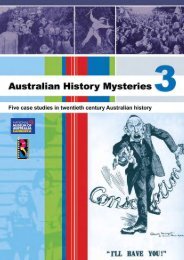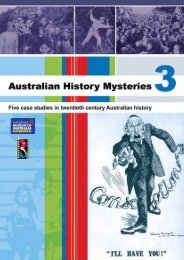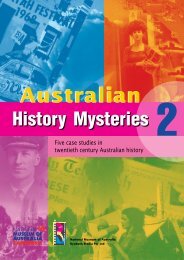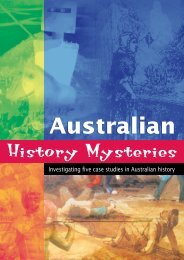Download Teacher Guide & Print Resources - Australian History ...
Download Teacher Guide & Print Resources - Australian History ...
Download Teacher Guide & Print Resources - Australian History ...
You also want an ePaper? Increase the reach of your titles
YUMPU automatically turns print PDFs into web optimized ePapers that Google loves.
Activity page<br />
12B<br />
Source 1<br />
Since my return to England many of my friends<br />
have expressed a wish to peruse my Journal<br />
…. It may not be deemed wholly uninteresting,<br />
when it is considered what important alterations<br />
the result of the expedition has produced in<br />
the immediate interests and prosperity of the<br />
colony. This appears in nothing more decidedly<br />
than the unlimited pasturage already afforded<br />
to the very fine flocks of merino sheep, as well<br />
as the extensive field opened for the exertions<br />
of the present, as well as future generations. It<br />
has changed the aspect of the colony, from a<br />
confined insulated tract of land, to a rich and<br />
extensive continent.<br />
Dedication by Blaxland in his Journal, 1823<br />
http://ebooks.adelaide.edu.au/b/blaxland/gregory/b64j/part1.html#part1<br />
Source 4<br />
In the first place, Macquarie did not plan a rapid peopling of the<br />
inland region — his plans for Bathurst ‘rested on the assumption<br />
that there was no pressing need for people to go there’. His<br />
proposed regulations for settlement were not approved until<br />
1817, and even then he took no immediate action to put then<br />
into effect. Although a few soldiers and labouring men had been<br />
stationed at Bathurst, there were no settlers until 1818, when<br />
ten grantees were finally put on small farms. In 1820 Macquarie<br />
was still rejecting proposals for a large-scale convict settlement<br />
on the grounds that it posed a security risk, and he had actively<br />
discouraged settlement by reserving large areas as Crown land.<br />
The Bathurst area remained for many years a small official<br />
outpost.<br />
Grace Karskens, An Historical and Archaeological Study of Cox’s Road and Early Crossings of<br />
the Blue Mountains, New South Wales, Crown lands Office, Bicentennial Project Unit,<br />
Sydney, 1988 p. 41<br />
Source 2<br />
Cox’s Road itself, rough and steep as it was,<br />
constituted the appropriate first step towards<br />
the Colony’s perceived future development: it<br />
marked the line of European ‘civilisation’ through<br />
the wilderness and made possible Macquarie’s<br />
official claim over the vast interior for some<br />
future imperial destiny.<br />
Grace Karskens, An Historical and Archaeological Study of Cox’s Road<br />
and Early Crossings of the Blue Mountains, New South Wales, Crown<br />
lands Office, Bicentennial Project Unit, Sydney, 1988<br />
Source 5<br />
In 1788 the Aborigines of the Blue Mountains had had no contact<br />
with Europeans; within 30 years their traditional way of life had<br />
been irrevocably changed. Of the generations of new Mountains<br />
dwellers who followed, few appreciated the Aboriginal heritage<br />
of the region, even though evidence of their presence was known<br />
from the Nepean River and the adjacent escarpment.<br />
Eugene Stockton and John Merriman (eds), Blue Mountains Dreaming: The Aboriginal Heritage<br />
(Second Edition), Blue Mountain Education and Research Trust, Lawson, 2009, back cover<br />
Source 6<br />
Source 3<br />
What was needed in the meantime was, firstly<br />
an official claiming of the region in symbolic<br />
and practical ways, laying suitable foundations<br />
for later development, and secondly a means by<br />
which the colony’s starving stock might quickly<br />
be taken into the new country. Cox’s Road served<br />
both purposes admirably. While not untruthful<br />
this description was exaggerated. For the journey<br />
over Cox’s Road proved to be extremely difficult<br />
and laborious. Significantly, as the numbers<br />
of travellers gradually increased, so the long<br />
process of re-alignment and improvement<br />
followed. Cox’s original road was simply not<br />
suitable for the transport and communication<br />
required for inland settlement, and so while it<br />
was of considerable symbolic importance, it had<br />
only limited actual economic usefulness.<br />
Grace Karskens, An Historical and Archaeological Study of Cox’s Road<br />
and Early Crossings of the Blue Mountains, New South Wales, Crown<br />
lands Office, Bicentennial Project Unit, Sydney, 1988<br />
Items on display in the Crossing of the Blue Mountains exhibit<br />
in the National Museum of Australia — iron axe heads and nails,<br />
a breastplate given by settlers to Aboriginal leaders, Aboriginal<br />
stone tools found in the Bathurst area.<br />
2 Could this display represent a comment on the impact<br />
of the new settlers on Aboriginal life and culture?<br />
Discuss this idea.<br />
Myths and Mysteries of the Crossing of the Blue Mountains<br />
41




